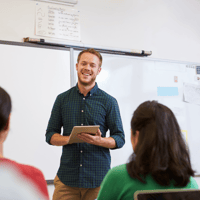“Nobody phrases it this way, but I think that artificial intelligence is almost a humanities...
Ideation to Innovation


Miranda Mears, Australian Impact Group
A few weeks ago The Australian Impact Group delivered a Women Who Ideate workshop at James Cook University as part of our Advance Queensland Stack Plus Female Founders Program.
Our objective was to create a space for exploring ideation across college disciplines and remove the mental barriers of entrepreneurship and innovation as not being for me’ often found in undergraduate students, early-stage professionals and traditional industries in regional and remote areas.
We just wanted to create a space for capability building in an area that at Australian Impact Group we are super passionate about. Business Analysis, Design Thinking and Structured Innovation.
We opened the session by asking a simple but often overlooked question: What is the difference between ideation and innovation?
Understanding this distinction is critical. Ideation is the process of generating, exploring, and shaping ideas. Innovation is applying those ideas to solve real problems and create new value.

In ecosystems, education and start up zones there can be a challenge for those looking in, who haven’t the confidence or clarity to perhaps see innovation as something reserved for a special few or the “Entrepreneurs”.
But… innovation doesn’t always show up as a product of genius or from a genius (although it can and does), It is often an outcome of clear thinking, structured exploration, and practical follow-through. It’s open to everyone if you can reverse engineer the secret sauce. And all of that begins with ideation.
Too often, we jump from idea to action, skipping the deeper work: pattern recognition, framing, questioning, challenging assumptions and reframing.
A quick sprint, a few stickies a hackathon, all done well can achieve great outcomes but only when it is done well and when it is followed through with action. Ideation isn’t a warm-up; It’s a core skill.
When we talk about innovation, we often focus on output. But the deeper value lies in helping people develop:
- Confidence in their creative and critical thinking
- Literacy in system dynamics and context mapping
- Tools for sense-making and structured exploration
This matters at all levels, but particularly in high school, undergraduate, and early career settings. Innovation should not be a siloed course or extracurricular badge. It needs to be recognised and cultivated as a cross-cutting capability, relevant to any discipline or role.
This blog explores why we must prioritise ideation capability early and widely. And why business analysis and design thinking should sit alongside leadership and project management as essential skills for future-focused teams, schools, and communities.
Thinking Before Doing: Why Capability Comes First
At the recent Women who idea the Workshop held at JCU, some confessed they didn’t know what to suspect and came along because they were taking the opportunity to make value out of all the non-core subject adjacent opportunities for students that JCU provide. How awesome is that.
In this workshop we used several of our Australian Impact Group Breakthrough Blueprints to showcase what structured ideation is in a way that was both meaningful and participant lead.
While we thought we would demonstrate something easy like engagement on campus, environment however what landed was hitting hard and heavy. Big-picture issues like housing, youth finance, and social systems through guided methods that showed how to think differently.
Conditions for Creativity: Open and Closed Modes
Creativity thrives when people understand how to work with their own thinking. John Cleese explored this in his 1991 lecture and subsequent book Creativity: A Short and Cheerful Guide, proposing a model that distinguishes between open and closed modes of thinking. Innovation requires both.
In open mode, we are curious, imaginative, and relaxed. This is the mode where new ideas form. In closed mode, we are focused and decisive—better suited to execution. Learning how to switch between the two is central to high-functioning teams and resilient individuals.
Cleese additionally outlined five conditions for accessing open mode:
- Space – A distraction-free setting to explore ideas.
- Time – Both a defined start and end, and adequate time to immerse.
- Time Again – The permission to let ideas incubate and return to them later.
- Confidence – Psychological safety to explore without premature judgement.
- Humour – A state of playfulness and psychological flexibility.
These align with the neurological and behavioural conditions known to support creativity. Psychologists such as Teresa Amabile and Mihaly Csikszentmihalyi have reinforced that intrinsic motivation, autonomy, and a low-threat environment support higher creative output.
|
Condition |
Open Mode (Exploratory) |
Closed Mode (Focused Execution) |
|
Time and Space |
Uninterrupted time, psychological safety |
Timed focus, boundaries, structured goals |
|
Risk and Judgment |
Safe to explore, no premature critique |
Judgement active, priorities defined |
|
Environment |
Calm, open-ended, curiosity encouraged |
Directed, outcome-focused, time-bound |
|
Mental State |
Playful, divergent, associative |
Structured, evaluative, convergent |
|
Output |
Ideas, connections, questions |
Plans, actions, decisions |
We embedded this model early in the JCU session to help participants notice how they were thinking, not just what they were thinking about. That small shift builds resilience, confidence, and clarity.
Creativity and the Changing Brain
When John Cleese described the conditions for creativity, he was reinforcing something neuroscience has since confirmed: the brain responds to how we think. When we slow down, explore without judgement, and give ourselves space to make connections, we strengthen our ability to think creatively.
Norman Doidge’s The Brain That Changes Itself brought neuroplasticity into mainstream conversation. Our neural pathways are shaped by use, not fixed by nature. This has deep implications for how we train minds and build capability. Whether in classrooms, in organisations, and across communities, every time we reframe a challenge or explore an unfamiliar path, we’re not just generating ideas, we are bulding cognitive agility.
This is particularly important in the current environment, where generative AI is accelerating content production but not always critical thinking. As we noted in our recent blog on the rise of sameness, overreliance on automation in creative tasks risks diminishing depth, originality, and even retention. Thinking takes effort. But that effort matters.
At our JCU Women who ideate workshop the focus what not so much on the generating ideas - although what was sparked was pretty impressive. The focus was on showing how to think differently using different models and to reinforce the perspective that ideation is not a talent, but as a trainable capability.
This shift is foundational for building resilience, adaptability, and confidence. It also reinforces that creativity isn’t separate from strategy or analysis. It’s part of it.
When I first started my first diploma in IT back in 1993 the light blub that sparked an interest in IT and systems as a career was one of Business Analysis and system design. I hadn’t heard of it before or that there was a career option exploding from this one concept.
What Is Business Analysis and Design Thinking—and Why They Matter
While leadership and project management receive strong emphasis in most professional development and training pathways, business analysis and design thinking often remain sidelined. Yet they are foundational capabilities for any individual or organisation that aims to navigate change effectively.
Business analysis helps teams uncover the real problems behind symptoms. It involves understanding systems, mapping dependencies, identifying constraints, and evaluating potential interventions. It’s a critical skillset for those who want to make informed, structured decisions.
Design thinking is a process for innovation that centres human experience. It uses empathy, problem framing, idea generation, prototyping, and iteration to move from challenge to outcome. It makes complexity more navigable, and helps translate insight into action.
Together, these skills:
- Build confidence in navigating uncertainty
- Help people break down messy, complex problems
- Support evidence-based decision-making
- Make ideation useful, not abstract
Too often, these capabilities are treated as secondary or specialist. But the ability to understand a problem deeply, question its framing, and design practical responses is relevant to every discipline, not just entrepreneurship or product development. Embedding these skills into education, onboarding, and leadership development creates far more adaptive and capable environments.
Breakthrough Blueprints in Practice
Our Breakthrough Blueprints were developed to give people an accessible way to begin this kind of thinking. At JCU, we used three:
- Brainmapping: To surface thought patterns, associations, blind spots introspectively mapping initial thoughts, themes and links and then collaboratively.
- Island Metaphor A metaphoric model of where you are and where you are going to reveal disconnections, system edges and changepoints
- Inside the box Thinking: Using structured constraints to reveal innovation opportunities in the sphere of possible.
Innovation Is a Capability, Not a Personality Type
The deeper aim of the workshop was not just to introduce a few tools, but to challenge the idea that innovation is something reserved for a certain kind of person or profession. It’s not.
Innovation is a process. It can be taught, developed, and refined. And if we want people to lead in ways that are future-focused and inclusive, we need to stop treating innovation like an elective.
We should be embedding ideation, business analysis, and design thinking early. Before career tracks narrow. Before students opt out. Before the belief takes hold that some people are just naturally good at this and others aren’t.
That’s why we do this work. And why we believe structured creativity should sit alongside the core skills we already prioritise.
Want to build innovation and ideation capability in your students and teams.
At Australian Impact Group, we believe capability is built, not born.
Whether you’re leading a team, teaching in a classroom, working in a startup hub, or guiding a community through change, these are the skills that build real problem-solving confidence.
If this resonated, we’d love you to stay connected. We regularly share insight-driven articles, practical approaches, and updates on the frameworks we use, including our Breakthrough Blueprints, which will soon be available as standalone resources.
Subscribe below to receive updates, reflections, and early access to upcoming product sets:
https://www.australianimpactgroup.com/subscribe-to-edm
Or explore how we work with education providers, teams, and innovation hubs here:
https://www.australianimpactgroup.com/advisoryandinnovation
.png?width=172&height=136&name=AIG%20LOGO%20NEW%20(185%20x%20150%20px).png)


